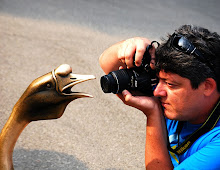The most immediate remarkable feature is the Carl Zeiss Vario-Sonnar T* lenses that boost a 8.3x optical zoom with a large F2.8 maximum aperture throughout an expansive 24-200mm zoom range (35mm equivalent format). Total zoom 16.6x including Digital Zoom. Optical stabilization - Steady shot.
Here is the camera with lenses collapsed. At this wide setting the macro working distance is 3cm from subject to front lens with maximum magnification ratio of 0.45.
And here is the camera with the lenses extended. The "macro" working distance is 30 cm from subject to front lens with maximum magnification ratio of 0.38.
The construction of the lens assembly has 14 elements in 11 groups (7 aspheric elements including advanced aspherical AA lens), providing a large F2.8 maximum aperture throughout an expansive 8.8-73.3mm focal length (24-200mm zoom range at 35mm equivalent format), range that gives you ample opportunity to express your creativity. To make a subject stand out — manipulate depth of field to defocus backgrounds for creative effect. We expect the Carl Zeiss Vario-Sonnar T* lens’ to optimize image quality consistently from edge to edge.
Bokeh should be OK but not spectacular due to the iris diaphragm - 7 blades.
The camera use a back-illuminated 1 inch (13.2mm x 8.8mm) 20.2-megapixel Exmor R CMOS sensor technology with approximately 4x larger light-sensitive area that other compact DSC (digital still cameras).
Here is a comparative size between a DSC sensor (yellow color) and Sony 1 inch sensor (magenta color).
Size wise the camera is exactly as an entry level DSLR on the market.
Dimensions (W x H x D): 129.0 x 88.1 x 102.2mm (5 1/8" x 3 1/2" x 4 1/8")
Weight wise it is heavy as an advanced level DSLR, mostly due to the weather proof construction (moisture and dust) and magnesium alloy body: approx. 813g (1lb 12.7oz.) - Battery and Memory Stick Duo included) / Approx. 755g (1lb 10.6oz.) (Body only)
The front of the camera reveal a lens filter thread of 62mm for those in need of creative filters. Other nice feature of the lens is the aperture ring switch that disable the click sound the ring is making when changing the aperture, for those using the camera in movie mode.

The focus assist light is also located on the front and the flash, while small in size, it raise automatic or with press of one button.
The grip is quite generous, rubber textured and comfortable to hold, feeling instantly familiar to anyone who’s handled a DSLR camera.The index finger sits naturally on the shutter button area while the thumb finger sits on the rest area, close to exposure compensation dial. Sony included a built-in 3EV Neutral Density Filter, that enable creative use of large aperture during bright light for creative effects.
The back of the camera feature a large 3.0 inch type TFT LCD screen on 4:3 format with 1,228,800 dots, tiltable to approx. 84 deg. up and approx. 43 deg. down. Too bad for creative effects, I dream of a swivel type scren that you can turn around - it would be nicer.
The camera can be operated in shooting mode with one hand due to the fact that all controls are located within thumb reach. For playback you have to use the left hand as Menu button is located in the left side of the camera.
The viewfinder is 0.39-type electronic viewfinder (OLED) with 1,440,000 dots with diopter adjustment of -4.0 to +3.0m-1, and it is the same used on NEX-6 camera. It has proximity sensor so it will switch off the LCD screen when you look in the viewfinder.
While you press the shutter button the images are handled by the new-generation, groundbreaking image processing engine BIONZ X that writes the JPEG and/or RAW files on the following media:
- Memory Stick Duo, Memory Stick PRO Duo, Memory Stick PRO Duo (High
Speed), Memory Stick PRO-HG Duo, Memory Stick XC-HG Duo, Memory Stick
Micro*7, Memory Stick Micro (Mark2)*7, SD Memory Card, SDHC Memory Card
(UHS-I), SDXC Memory Card (UHS-I), microSD Memory Card*8, microSDHC
Memory Card*7, microSDXC Memory Card*.
Autofocus is fast and responsive, thanks to the new Direct Drive SSM
mechanism.
Sony RX-10
has HDMI and USB connectors, 3.5mm microphone input and even 3.5mm audio
output for sound monitoring headphones. Wi-Fi and NFC are also built-in
and only GPS might be added to make it perfect.
There is still one open question though:
the price. I have been told it will cost in the 1300 EURO range in
Europe and that is quite steep (USA will get it for $1300 what is a bit
cheaper). You could get Nikon D7100 or Canon 70D with 18-135 lens at
this price and these cameras are better than RX10. Still, a lot of users
do not want interchangeable lens camera and this might be the best
all-in-one solution in years. The price will most surely fall in a few
months time and this camera might a best-seller.
Sony Press Release:
Premium performance and portability; Full range shooting from wide angle to telephoto
Cyber-shot™ RX10 premium bridge camera offers DSLR-style creative power without the need to carry interchangeable lenses
|
There is a lot to say about this camera, for the moment I stop here. More to come as I cannot wait to buy one!
By SEN




















